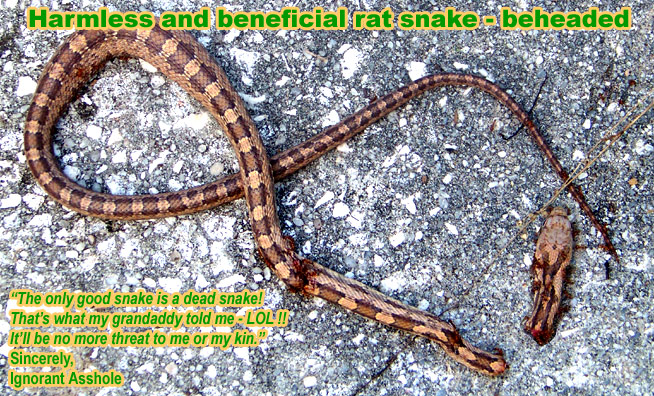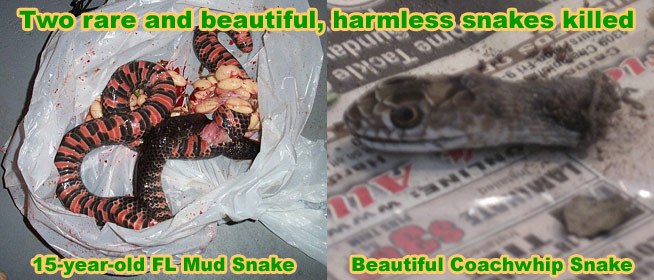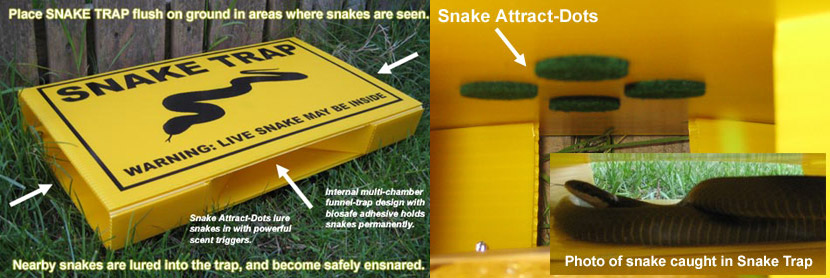Most people kill snakes with garden tools, some with handguns. I have received many, many emails over the years, of snakes that people have killed, and now want identified, such as seen below. In none of the
cases have the snakes been venomous. I have, however, talked to emergency room technicians who have seen venomous snake bites. IN EVERY CASE, THE BITES OCCURRED WHEN PEOPLE TRIED TO CATCH OR KILL THE SNAKES. Here
are some important things to know:
- A snake will never strike for no reason - strikes occur when provoked or surprised.
- Almost all snakes that people see are harmless, and beneficial to have around.
- Only a few venomous bites occur in the US per year - and most of them happen when people are attempting to kill or get rid of the snakes. Just leave 'em alone!

Hey, if you are set on killing a snake, I guess there's nothing I can say to stop you. But if you bother to read this, please think about it before you do so.
Before you kill the snake, learn: How can you tell if a snake is venomous? (top three traits).
We don't live in a world full of monsters out to get people - snakes! sharks! vampires (you are actually more likely to be killed by a human dressed as a vampire than by these animals - it's a real stat! Look it up!). We live in a world in which people utter dominate and destroy so many of our beautiful fellow wild creatures. Snakes are some of the most persecuted of all, due to unfounded fears.
Snakes have a hard enough time trying to survive in a world of decreasing habitat, cars that crush them, pesticides, etc. They don't need deliberate killing. If you don't want snakes around, instead of asking how to kill snakes, ask how to prevent them.
Before you try to kill a snake inside your home or on your property, you should be aware of the fact that most snake bites occur when people are attempting to kill a snake. The vast majority of people do not research the why of snake killing, and instead set out with an axe, hammer, or bat to bludgeon the animal to death. This method can be effective, but it puts you at arm’s length of an animal that will defend itself, as any animal will do. You can use something with a little more reach, like a garden hoe, but again, snakes have been known to breach such distances easily when they strike.
Snakes are no different than any other animal. So when it comes to lethal elimination tactics, much of the same principals apply. You can shoot a snake, but guns are dangerous no matter how careful you are, you may break neighborhood gun laws in the process, and you’d better be a good shot or you’ll have to be close enough that you might get bit anyway. The garden-tool-to-the-head is the most popular method for the panicky homeowner. Again, while effective, this method puts you at risk by aggravating a snake and increasing its aggression. Chances are, if you were able to kill a snake on first strike, the animal probably wasn’t venomous. Most lethal snakes are thick and tough and incredibly quick and will dodge the first few strikes of a shovel or hoe. Now the venomous snake is frightened and angry and that is never a good thing.

How to kill snakes in the house - if you need to kill a snake inside our around the house, once again, your best bet is to shoo it out with a broom, or just leave a door open and let it out on its own. Or a snake trap is actually super effective in this case of actually catching the snake, which you can then bring outside and release. Is there such a thing as snake poison - a poison that will kill snakes? Of course not. Snakes don't eat often, and when they do, they catch live food and eat it. Any animal that catches its food live can't be administered any poison bait.
Some pest control companies market lethal snap traps, working on the theory that a snake will enter a trap head first, much like a mouse. The reality is that snake traps of this nature rarely snap a snake directly on the head as they are supposed to. Instead, the snake will often be caught in the device but not killed, resulting in an injured and angry snake thrashing around the yard. This situation can be even more dangerous to a homeowner than if they had tried to whack the creature to death. The snake lodged in the ineffective trap will be very dangerous because it is injured and fearful. Getting close enough to finish the job at this point will leave you more prone to injury.
Most snakes do not need to be killed. That is a hard concept for some of the persnickety homeowners out there, but it is the reality. Snakes are very beneficial to the environment, killing problematic rodents and keeping those populations in check. The majority of snakes on a property are not poisonous and pose no immediate danger to a pet or a child.
If the only issue with a snake on the property is its presence, it is often easier to trap and remove the snake than it is to kill it. This is often something you can do on your own, but if the notion of catching and removing a snake is too much for you, you always have the option of calling in a professional. Homeowners brave enough to take on the task will need to research the tools available. A number of non-lethal snake traps exist. The most popular traps are box-type traps, luring the snake into an enclosure through the use of rodent scent. At this point, the traps designs differ. Some are simply boxes that can be closed and sealed once the snake is inside. For a non-venomous snake this might work fine, but remember that you’ll be putting your hand perilously close to where the snake is contained. Instead of taking the risk, glue traps are probably the most effective method of non-lethal snake removal.
Glue traps are box-like but have an inner lining of glue that will hold the snake in place once the animal enters the box. If checked regularly, the glue trap can be used to remove and relocate the snake to a new area. Traps that are left out and forgotten about will often result in a snake that has died of starvation—not a very pleasant way to go—or a snake that has escaped because the glue began to break down. Snakes are intelligent creatures. Letting one escape a glue trap can be a huge detriment to your attempts to catch the serpent. Once the trap has been identified as dangerous, the snake may never go near it again.
The only good snake is a dead snake - dead wrong, and the belief of bad people. Snakes are great animals. They ought to be treated with respect.
You basically have two options for getting rid of your snake(s) without killing them. First, you can call a professional wildlife expert from my below directory. This person can catch and remove the snake(s) and take other actions necessary to solve the snake problem. Although they know how to kill a snake safely, no one on my list would actually do so. They are humane relocators. Second, you can purchase a snake trap if you wish to catch the snake yourself. It's easy to release the snake from the trap to relocate it - instructions to do so are included with the trap.
Option 1 - HIRE A PROFESSIONAL
We can solve your snake problem for you. Our nationwide group of snake specialists services 95% of the US population. Click here to find your local snake removal expert in your town. Below are just some of our more popular areas:Option 2 - BUY A SNAKE TRAP
If a snake is indoors, a trap will work. I do not recommend using a glue-based trap outdoors, because it can inhumanely catch other small critters. I have reviewed and field tested several snake trap designs, and the one featured below is the most durable and effective. It allows you to safely catch and easily relocate a snake, so you don't kill it. It is the highest quality snake trap available on the market. Read more about Snake Trap.
For more information, go to my Snake Removal - How to Get Rid of Snakes home page.